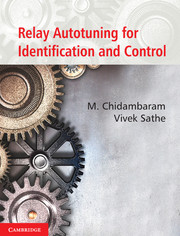Book contents
- Frontmatter
- Contents
- List of Figures
- List of Tables
- Acknowledgements
- Preface
- 1 Introduction
- 2 Improved Autotune Identification Methods
- 3 Cascade Controllers Tuning by Relay Autotune Method
- 4 Simultaneous Relay Autotuning of Cascade Controllers
- 5 A Simple Method of Tuning Cascade Controllers
- 6 Improved Saturation Relay Test for Systems with Large Dead Time
- 7 Identification of FOPTD Model using Single Symmetrical Relay Test
- 8 Autotuning of PID Controllers for Unstable FOPTD Systems
- 9 Autotuning of PID Controllers for Critically Damped SOPTD Systems
- 10 Estimation of SOPTD Transfer Function Model
- 11 Estimation of Five Parameters of Unstable SOPTD Model with a Zero
- 12 Identification of FOPTD Multivariable Systems
- 13 Identification of SOPTD Multivariable Systems
- 14 Tuning of Multivariable Controllers for Non-Minimum Phase Systems
- 15 Tuning of Multivariable Controllers by Genetic Algorithms
- 16 Summary and Conclusions
- Appendix A
- Appendix B
- Appendix C
- Nomenclature
- Problems
- Suggestive Reading
- References
- Index
10 - Estimation of SOPTD Transfer Function Model
Published online by Cambridge University Press: 05 June 2014
- Frontmatter
- Contents
- List of Figures
- List of Tables
- Acknowledgements
- Preface
- 1 Introduction
- 2 Improved Autotune Identification Methods
- 3 Cascade Controllers Tuning by Relay Autotune Method
- 4 Simultaneous Relay Autotuning of Cascade Controllers
- 5 A Simple Method of Tuning Cascade Controllers
- 6 Improved Saturation Relay Test for Systems with Large Dead Time
- 7 Identification of FOPTD Model using Single Symmetrical Relay Test
- 8 Autotuning of PID Controllers for Unstable FOPTD Systems
- 9 Autotuning of PID Controllers for Critically Damped SOPTD Systems
- 10 Estimation of SOPTD Transfer Function Model
- 11 Estimation of Five Parameters of Unstable SOPTD Model with a Zero
- 12 Identification of FOPTD Multivariable Systems
- 13 Identification of SOPTD Multivariable Systems
- 14 Tuning of Multivariable Controllers for Non-Minimum Phase Systems
- 15 Tuning of Multivariable Controllers by Genetic Algorithms
- 16 Summary and Conclusions
- Appendix A
- Appendix B
- Appendix C
- Nomenclature
- Problems
- Suggestive Reading
- References
- Index
Summary
In this chapter, using a single asymmetric relay feedback test, a method proposed by Ramakrishnan and Chidambaram (2003) is reviewed to identify four parameters of a transfer function model. The proposed method is used to identify all the parameters in a second order plus time delay model (SOPTD). The parameters estimated are of adequate accuracy for designing suitable controllers. The estimated SOPTD model has a step response behavior matching with that of the actual process. The method can also be used for identifying open loop unstable transfer function models. For unstable systems, the closed loop step responses are compared. Simulation results are given for four case studies.
Introduction
Identification of dynamic transfer function models from experimental data is essential for model-based controller design. Often derivation of rigorous models is difficult due to the complex nature of chemical processes. Hence, system identification is a valuable tool to identify low order models, based on input–output data, for controller design.
As stated earlier in Chapter 1, Åström and Hägglund (1984) suggested the relay feedback test to generate sustained oscillations of the controlled variable and get the ultimate gain (Ku) and ultimate frequency (ωu) directly from the experiment. Since only process information Ku and ωu are available, the additional information such as steady-state gain or time delay should be known a priori in order to fit a typical transfer function model such as first order plus time delay (FOPTD).
- Type
- Chapter
- Information
- Relay Autotuning for Identification and Control , pp. 143 - 150Publisher: Cambridge University PressPrint publication year: 2014



